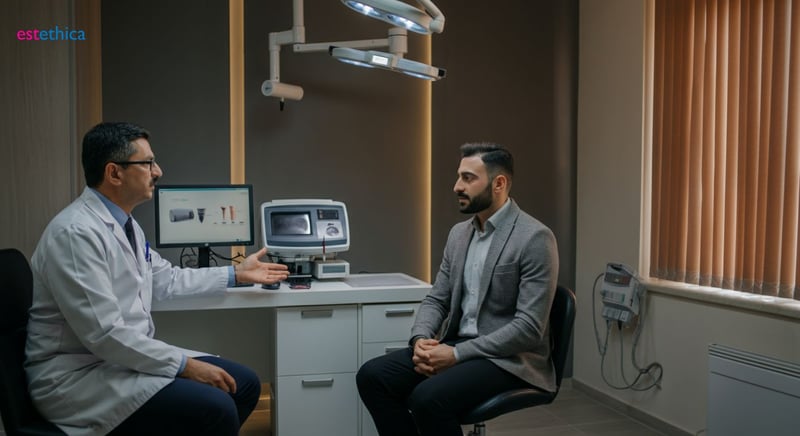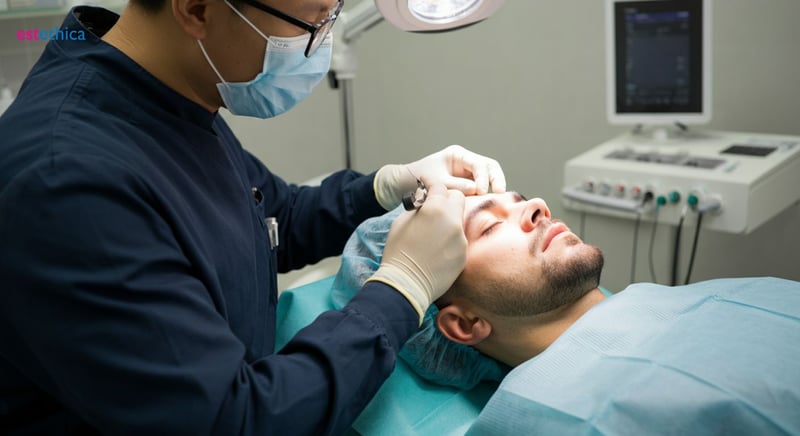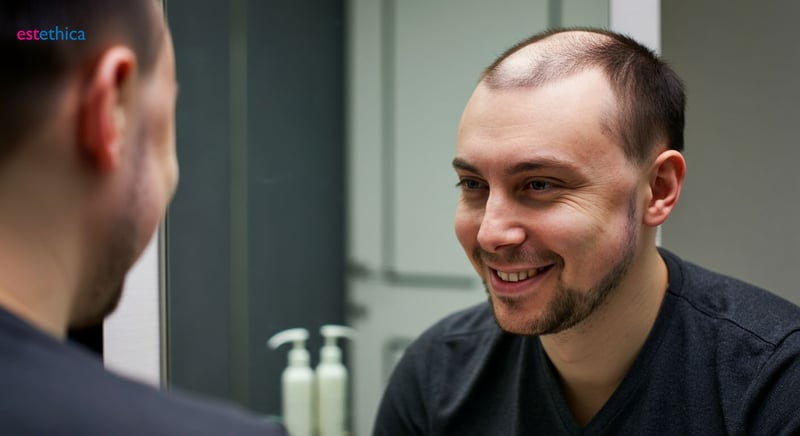Hair Transplant Revolution: Unlocking Natural-Looking Results
Discover the hair transplant revolution with advanced FUE and DHI techniques—natural results in record time. Learn more at estethica.
Hair transplants have revolutionized the way individuals approach hair restoration, providing natural-looking results and boosting confidence. With advanced techniques like FUE and DHI, patients enjoy minimally invasive procedures that assure long-term satisfaction. Join us as we explore the specifics of these methods and the recovery journey to ensure the best outcomes.
FUE vs. DHI: Choosing the Right Hair Transplant Technique for You
Key Differences Between FUE and DHI
The debate between Follicular Unit Extraction (FUE) and Direct Hair Implantation (DHI) centers on how hair follicles are extracted and implanted. FUE involves individually extracting follicles from the donor area, offering enhanced precision for larger areas needing coverage. Conversely, DHI employs a specialized pen-like device for simultaneous extraction and implantation, leading to potentially faster recovery times. Recent advancements like Safir pens in FUE aim to minimize scarring, helping to discover the best FUE hair transplant techniques. The Multi Implanter in DHI enhances hair density and natural look.
Factors to Consider When Choosing a Hair Transplant Method
Choosing between FUE and DHI hair transplant depends on individual needs. Considerations include the extent of hair loss and desired density. FUE is often preferred for extensive hair thinning because each follicle is taken individually, and gives a more natural look. DHI may be advantageous for those looking for quicker recovery and higher hair density due to its direct implantation method. The method is also influenced by technological innovations like Safir pens and Multi implanters and can change the success rates. The Multi Implanter in DHI is able to assist doctors with its technology in the DHI method.

Is a Hair Transplant Permanent? Understanding Long-Term Expectations
Factors Influencing the Longevity of Hair Transplants
Hair transplants are generally considered a lasting solution for hair loss, primarily because the transplanted hair follicles are taken from areas of the scalp that are genetically resistant to balding. This involves harvesting follicles from areas unaffected by hair loss such as the back or sides of the head. However, the success and longevity of the transplant depend significantly on several factors, most notably the skill of the surgical team and adherence to post-operative care guidelines. Proper care ensures the transplanted follicles properly integrate into the scalp and receive the necessary nutrients for sustained growth. For instance, the first few weeks after the procedure are crucial for follicle establishment, requiring gentle care to avoid dislodging the new grafts.
Essential elements for maintaining successful hair transplant results:
- Expert Surgical Technique: Skilled surgeons at estethica use precise methods like FUE and DHI to ensure minimal trauma to follicles, maximizing their survival rate.
- Personalized Post-Operative Care: Following a strict regimen of care, including medication and gentle washing, is essential to foster good graft integration.
- Healthy Lifestyle Choices: Maintaining a nutrient-rich diet and avoiding smoking can improve blood flow to the scalp, promoting healthier hair growth.
At estethica, our approach focuses on delivering results that not only restore your hair but also stand the test of time. We emphasize patient education, ensuring you understand how lifestyle choices and proper maintenance impact the long-term success of your hair transplant. By choosing estethica, you are opting for a partner dedicated to optimizing your aesthetic outcome with expertise and care. This commitment ensures that your investment in hair restoration yields satisfying and sustainable results.

Navigating Hair Transplant Recovery: Timeline and Essential Aftercare
The Initial Days and Weeks Post-Transplant
Recovery following a hair transplant varies, particularly within the first few days and weeks. Patients might encounter minor discomfort, generally manageable with prescribed medications. Essential practices include avoiding direct exposure to sunlight and refraining from strenuous activities to ensure the grafts remain undisturbed. For those who opt for a DHI hair transplant, the absence of large incisions typically results in a quicker recovery, often allowing individuals to resume work and normal activities within a few days. estethica emphasizes a carefully structured aftercare process designed to significantly enhance both graft survival and overall hair vitality.
Essential Steps for Optimal Aftercare
- Gentle Washing Techniques: Use of specific shampoos recommended by estethica to minimize disturbance to the grafts.
- Medication Adherence: Consistent adherence to prescribed antibiotics and anti-inflammatory medications to prevent infection and reduce swelling.
- Protective Measures: Strict avoidance of direct sunlight and physical activities that could dislodge the newly implanted hair follicles.

Beyond Hair Loss: Exploring Hair Restoration and Thinning Solutions
Advanced Therapies for Hair Thinning
Beyond surgical solutions like FUE hair transplant and DHI hair transplant, estethica offers a spectrum of advanced therapies designed to combat various forms of hair thinning. These treatments are tailored to improve scalp health and stimulate hair growth at a cellular level. Mesotherapy, for instance, involves injecting a customized blend of vitamins, minerals, and amino acids directly into the scalp to nourish hair follicles. Advanced laser treatments use low-level light therapy to enhance cellular activity and promote circulation, which can revitalize dormant follicles and thicken existing hair. Each therapy is customized at estethica to meet individual needs, ensuring optimal results for various types of hair loss.
Complementary treatments offered at estethica:
- Mesotherapy: A targeted approach to nourish and stimulate hair follicles directly at the scalp.
- Laser Therapy: Utilizes low-level light to enhance cellular energy and blood flow, essential for hair rejuvenation.
- Personalized Scalp Care: Diagnostic techniques for treatments to address individual conditions.
Safir FUE and Multi-Implanter DHI: Precision Hair Restoration Techniques
estethica Global employs advanced hair restoration techniques including Follicular Unit Extraction (FUE) with Safir pens to minimize scarring and Direct Hair Implantation (DHI) with the Multi Implanter for enhanced hair density. These methods allow for precise extraction and implantation, leading to natural-looking results.
estethica Global specializes in advanced hair restoration, offering tailored solutions for various types of hair loss. Their expertise extends to both surgical and non-surgical options, ensuring patients receive the most appropriate treatment for their individual needs.
Comprehensive Aftercare: Ensuring Graft Survival and Hair Vitality
estethica Global ensures graft survival and hair vitality through a carefully structured aftercare process, including gentle washing techniques with recommended shampoos and consistent adherence to prescribed medications and anti-inflammatory treatments. Strict avoidance of direct sunlight and physical activities that could dislodge the newly implanted hair follicles is emphasized.
Patients at estethica Global benefit from personalized treatment plans, including advanced therapies such as mesotherapy and laser treatments, designed to improve scalp health and stimulate hair growth. These are customized to individual needs to optimise outcomes, ensuring optimal results for various types of hair loss.
Frequently Asked Questions
What are the key advantages when comparing FUE vs DHI hair transplant techniques?
How can I ensure the longevity of my long-term hair restoration results after a hair transplant?
What should I expect during the initial recovery phase, and what are some essential hair transplant recovery tips?
Besides hair transplants, what advanced hair thinning solutions are available to improve scalp health and stimulate hair growth?
What makes the Safir FUE and Multi-Implanter DHI techniques superior for achieving truly natural hair transplant outcomes?
Need expert assistance? Let us help you find the perfect solution.
📞 Call Now for Free Support!